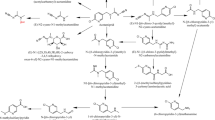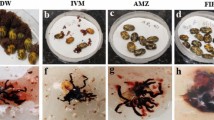Abstract
Russell’s vipers are snakes of major medical importance in Asia. Russell’s viper (Daboia russelii) envenoming in Sri Lanka and South India leads to a unique, mild neuromuscular paralysis, not seen in other parts of the world where the snake is found. This study aimed to identify and pharmacologically characterise the major neurotoxic components of Sri Lankan Russell’s viper venom. Venom was fractionated using size exclusion chromatography and reverse-phase high-performance liquid chromatography (RP-HPLC). In vitro neurotoxicities of the venoms, fractions and isolated toxins were measured using chick biventer and rat hemidiaphragm preparations. A phospholipase A2 (PLA2) toxin, U1-viperitoxin-Dr1a (13.6 kDa), which constitutes 19.2 % of the crude venom, was isolated and purified using HPLC. U1-viperitoxin-Dr1a produced concentration-dependent in vitro neurotoxicity abolishing indirect twitches in the chick biventer nerve-muscle preparation, with a t 90 of 55 ± 7 min only at 1 μM. The toxin did not abolish responses to acetylcholine and carbachol indicating pre-synaptic neurotoxicity. Venom, in the absence of U1-viperitoxin-Dr1a, did not induce in vitro neurotoxicity. Indian polyvalent antivenom, at the recommended concentration, only partially prevented the neurotoxic effects of U1-viperitoxin-Dr1a. Liquid chromatography mass spectrometry analysis confirmed that U1-viperitoxin-Dr1a was the basic S-type PLA2 toxin previously identified from this venom (NCBI—GI: 298351762; SwissProt: P86368). The present study demonstrates that neurotoxicity following Sri Lankan Russell’s viper envenoming is primarily due to the pre-synaptic neurotoxin U1-viperitoxin-Dr1a. Mild neurotoxicity observed in severely envenomed Sri Lankan Russell’s viper bites is most likely due to the low potency of U1-viperitoxin-Dr1a, despite its high relative abundance in the venom.




Similar content being viewed by others
References
Ariaratnam CA, Meyer WP, Perera G et al (1999) A new monospecific ovine FAb fragment antivenom for treatment of envenoming by the Sri Lankan Russell’s viper (Daboia russelli russelli): a preliminary dose-finding and pharmacokinetic study. Am J Trop Med Hyg 61:259–265
Ba-Aye, Tun-Pe, Aye-Aye-Myint et al (1991) Bites by Russell’s vipers (Daboia russelii siamensis) in Myanmar: effect of the snake’s length and recent feeding on venom antigenaemia and severity of envenoming. Trans R Soc Trop Med Hyg 85:804–808
Barber CM, Isbister GK, Hodgson WC (2012) Solving the “Brown snake paradox”: in vitro characterisation of Australasian snake presynaptic neurotoxin activity. Toxicol Lett 210:318–323
Belt P, Warrell D, Malhotra A, et al (1997) Russell’s viper in Indonesia: snakebite and systematics. In: Thorpe R, Wüster W, Malhotra A (eds) Venomous snakes: ecology, evolution and snakebite. Symposia of the zoological society of London, vol. 70. Clarendon Press, Oxford, pp 219–234
Chaisakul J, Konstantakopoulos N, Smith A, Hodgson W (2010) Isolation and characterisation of P-EPTX-Ap1a and P-EPTX-Ar1a: pre-synaptic neurotoxins from the venom of the northern (Acanthophis praelongus) and Irian Jayan (Acanthophis rugosus) death adders. Biochem Pharmacol 80:895–902
Hodgson WC, Dal Belo CA, Rowan EG (2007) The neuromuscular activity of paradoxin: a presynaptic neurotoxin from the venom of the inland taipan (Oxyuranus microlepidotus). Neuropharmacology 52:1229–1236
Hung D-Z, Wu M-L, Deng J-F, Lin-Shiau S-Y (2002) Russell’s viper snakebite in Taiwan: differences from other Asian countries. Toxicon 40:1291–1298
Hung D-Z, Yu Y-J, Hsu C-L, Lin T-J (2006) Antivenom treatment and renal dysfunction in Russell’s viper snakebite in Taiwan: a case series. Trans R Soc Trop Med Hyg 100:489–494
Jayanthi GP, Gowda TV (1988) Geographical variation in India in the composition and lethal potency of Russell’s viper (Vipera russelli) venom. Toxicon 26:257–264
Jayanthi G, Kasturi S, Gowda TV (1989) Dissociation of catalytic activity and neurotoxicity of a basic phospholipase A2 from Russell’s viper (Vipera russelli) venom. Toxicon 27:875–883
Kasturi S, Gowda TV (1989) Purification and characterization of a major phospholipase A2 from Russell’ s viper (Vipera russelli) venom. Toxicon 27:229–237
King GF, Gentz MC, Escoubas P, Nicholson GM (2008) A rational nomenclature for naming peptide toxins from spiders and other venomous animals. Toxicon 52:264–276
Kularatne SAM (2000) Epidemiology and clinical picture of the Russell’s viper (Daboia russelli russelli) bite in Anuradhapura, Sri Lanka: a prospective study of 336 patients. Souteast Asian J Trop Med Public Heal 34:855–862
Kularatne SAM, Silva A, Weerakoon K et al (2014) Revisiting Russell’s viper (Daboia russelii) bite in Sri Lanka: is abdominal pain an early feature of systemic envenoming? PLoS One 9:e90198. doi:10.1371/journal.pone.0090198
Kuruppu S, Reeve S, Banerjee Y et al (2005) Isolation and pharmacological characterization of cannitoxin, a presynaptic neurotoxin from the venom of the Papuan Taipan (Oxyuranus scutellatus canni). J Pharmacol Exp Ther 315:1196–1202
Maduwage K, Silva A, O’Leary MA et al (2016) Efficacy of Indian polyvalent snake antivenoms against Sri Lankan snake venoms: lethality studies or clinically focussed in vitro studies. Sci Rep 6:26778. doi:10.1038/srep26778
Mukherjee AK, Maity CR (2002) Biochemical composition, lethality and pathophysiology of venom from two cobras—Naja naja and N. kaouthia. Comp Biochem Physiol B: Biochem Mol Biol 131:125–132
Mukherjee AK, Ghosal SK, Maity CR (2000) Some biochemical properties of Russell’s viper (Daboia russelli) venom from Eastern India: correlation with clinico-pathological manifestation in Russell’s viper bite. Toxicon 38:163–175
Myint-Lwin Warrell D, Phillips R et al (1985) Bites by Russell’s viper (Vipera russelli siamensis) in Burma: haemostatic, vascular, and renal disturbances and response to treatment. Lancet 2:427–433
Phillips RE, Theakston RDG, Warrell DA et al (1988) Paralysis, rhabdomyolysis and haemolysis caused by bites of Russell’s Viper (Vipera russelli pulchella) in Sri Lanka: failure of Indian (Haffkine) antivenom. Q J Med 68:691–716
Prasad N, Uma B, Bhatt SKG, Gowda V (1999) Comparative characterisation of Russell’s viper (Daboia/Vipera russelli) venoms from different regions of the Indian peninsula. Biochim Biophys Acta 1428:121–136
Sharma M, Gogoi N, Dhananjaya BL et al (2014) Geographical variation of Indian Russell’s viper venom and neutralization of its coagulopathy by polyvalent antivenom. Toxin Rev 33(7–15):9
Shelke R, Sathish S, Gowda TV (2002) Isolation and characterization of a novel postsynaptic/cytotoxic neurotoxin from Daboia russelli russelli venom. J Pept Res 59:257–263
Silva A, Maduwage K, Sedgwick M et al (2016) Neurotoxicity in Russell’s viper (Daboia russelii) envenoming in Sri Lanka: a clinical and neurophysiological study. Clin Toxicol. 54:411–419
Suzuki M, Itoh TIK, Bandaranayake BMA et al (2010) Molecular diversity in venom proteins of the Russell’s viper (Daboia russellii russellii) and the Indian cobra (Naja naja) in Sri Lanka. Biomed Res 31:71–81
Tan NH, Fung SY, Tan KY et al (2015) Functional venomics of the Sri Lankan Russell’s viper (Daboia russelii) and its toxinological correlations. J Proteomics 128:403–423
Thorpe RS, Pook CE, Malhotra A (2007) Phylogeography of the Russell’s viper (Daboia russelii) complex in relation to variation in the colour pattern and symptoms of envenoming. Herpetol J 17:209–218
Tsai I, Lu P, Su J (1996) Two types of Russell’s viper revealed by variation in phospholipases A2 from venom of the subspecies. Toxicon 34:99–109
Venkatesh M, Prasad N, Sing T, Gowda V (2013) Purification, characterization, and chemical modification of neurotoxic peptide from Daboia russelii snake venom of India. J Biochem Mol Toxicol 27:295–304
Warrell DA (1989) Snake venoms in science and clinical medicine. 1. Russell’ s viper: biology, venom and treatment. Trans R Soc Trop Med Hyg 83:732–740
Wuster W, Otsuka S, Malhotra A, Thorpe RS (1992) Population systematics of Russell’s viper: a multivariate study. Biol J Linn Soc 47:97–113
Acknowledgments
We thank Ariaranee Gnanadasan (Faculty of Medicine – University of Colombo) for kindly supplying Sri Lankan Russell’s viper venom for this study. Daniela Kniesz (Monash Venom Group) is acknowledged for various assistances in chromatography. GKI is funded by a National Health and Medical Research Council – Australia (NHMRC) Senior Research Fellowship (ID: 1061041) and NHMRC Centres for Research Excellence Grant ID: 1110343.
Author information
Authors and Affiliations
Corresponding author
Rights and permissions
About this article
Cite this article
Silva, A., Kuruppu, S., Othman, I. et al. Neurotoxicity in Sri Lankan Russell’s Viper (Daboia russelii) Envenoming is Primarily due to U1-viperitoxin-Dr1a, a Pre-Synaptic Neurotoxin. Neurotox Res 31, 11–19 (2017). https://doi.org/10.1007/s12640-016-9650-4
Received:
Revised:
Accepted:
Published:
Issue Date:
DOI: https://doi.org/10.1007/s12640-016-9650-4




